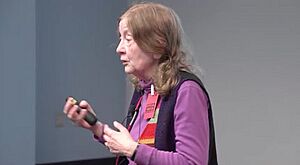Eugenia Kalnay facts for kids
Quick facts for kids
Eugenia Kalnay
|
|
|---|---|
 |
|
| Born | 1 October 1942 Argentina
|
| Died | 14 August 2024 (aged 81) Maryland, U.S.
|
| Scientific career | |
| Fields | Meteorology |
| Institutions | University of Maryland |
| Doctoral advisor | Jule Gregory Charney |
Eugenia Enriqueta Kalnay (born 1 October 1942 – died 14 August 2024) was an important Argentine meteorologist. A meteorologist is a scientist who studies the Earth's atmosphere and weather. She was a special professor at the University of Maryland, where she taught about the atmosphere and oceans.
In 1996, Eugenia Kalnay was chosen to be a member of the National Academy of Engineering. This was because she helped us understand how the atmosphere works. She also improved how we use computers to predict weather. Her work made U.S. weather forecasts much better.
In 2009, she won the 54th International Meteorological Organization Prize. This award came from the World Meteorological Organization. She earned it for her work on numerical weather prediction, which uses computers to forecast weather. She also worked on data assimilation, which means combining observations with computer models. Another area was ensemble forecasting, which uses many forecasts to get a better prediction.
As a director at the Environmental Modeling Center, she helped publish a very famous paper in 1996. This paper was about the "NCEP/NCAR 40-year reanalysis project." This project looked back at 40 years of weather data. It helped scientists understand past weather patterns better. She wrote or co-wrote over 120 science papers. She also wrote a book called Atmospheric Modeling, Data Assimilation and Predictability in 2003.
Early life and career
Eugenia Kalnay was born in Argentina. She studied meteorology at the University of Buenos Aires. She finished her first degree in 1965. In 1971, she made history at MIT. She was the first woman to get a PhD in meteorology from that university. Her advisor was Jule Charney, a famous scientist. After her PhD, she became the first female professor in the MIT Department of Meteorology.
In 1979, she started working at NASA Goddard. By 1984, she was leading a group that modeled the Earth's atmosphere. From 1987 to 1997, Kalnay was the Director of the Environmental Modeling Center (EMC). This center is part of the National Weather Service. She led the NCEP/NCAR reanalysis project there. This project helped scientists understand past weather patterns. She also worked on many other projects. These projects involved combining weather data and making many forecasts at once.
After leaving the EMC, Kalnay became a professor at the University of Oklahoma. In 2002, she joined the Department of Atmospheric and Oceanic Science at the University of Maryland, College Park. She even became the head of that department.
Scientific contributions
Eugenia Kalnay helped start the Weather/Chaos Group at the University of Maryland. She worked with James A. Yorke on this group. They found new ways to understand unstable areas in the atmosphere. They also created new methods for combining weather data. These methods are called Local Ensemble Kalman filter and Local Ensemble Transform Kalman Filter.
Besides her main department, Kalnay also worked with other groups at the University of Maryland. These included the Institute for Physical Science and Technology. She also worked with the Center for Computational Science and Mathematical Modeling. In 2008, she was chosen for a special professorship. It was named the Eugenia Brin Endowed Professorship in Data Assimilation.
Among her many scientific methods, Kalnay developed the "breeding method." She introduced this method with Zoltan Toth. It helps find small changes that can grow quickly in a weather system. She also helped create other forecasting methods. These included Lag Averaged Forecasting (LAF) and Scaled LAF.
In 2017, Kalnay was part of a group of scientists. They published a study about climate change models. The study suggested that some important parts were missing from these models. These missing parts affect how we predict future climate and economic changes. Kalnay believed that without including real feedback, predictions for complex systems would not work well. She said models could quickly become inaccurate without it.
Eugenia Kalnay passed away on 14 August 2024. She was 81 years old.
Awards and honors
Eugenia Kalnay received many important awards for her work. She was also a member of several important scientific groups. These included the American Geophysical Union and the American Meteorological Society. She was also part of the American Association for the Advancement of Science. In 1996, she became a member of the National Academy of Engineering. In 2000, she became a foreign member of the Academia Europaea. She also joined the Argentine National Academy of Physical Sciences in 2003.
Here are some of her major awards:
- American Meteorological Society The Jagadish Shukla Earth System Predictability Prize (2023)
- American Geophysical Union's Roger Revelle Medal (2019)
- American Meteorological Society Eugenia Kalnay Symposium (2015)
- American Meteorological Society Honorary Member Award (2015)
- American Meteorological Society Joanne Simpson Mentorship Award (2015)
- Lorenz Lecturer (2012), a lecture named after Edward Lorenz
- 54th International Meteorological Organization Prize (2009) from the World Meteorological Organization
- Doctor Honoris Causa, University of Buenos Aires (2008)
- First Eugenia Brin Professorship in Data Assimilation (2008)
- Distinguished University Professor, University of Maryland (2001)
- Bjerknes Lecturer (1999), a lecture named after Jacob Bjerknes
- American Meteorological Society Jule G. Charney Award (1995)
- National Aeronautics and Space Administration gold medal for Exceptional Scientific Achievement (1981)
See also
 In Spanish: Eugenia Kalnay para niños
In Spanish: Eugenia Kalnay para niños

